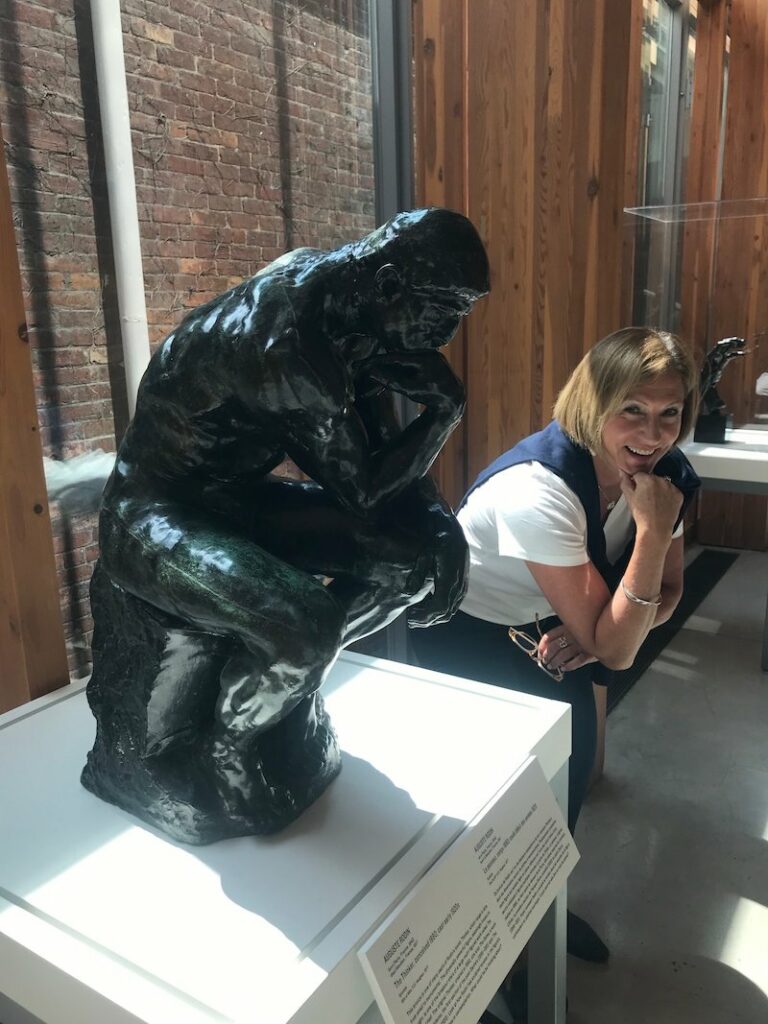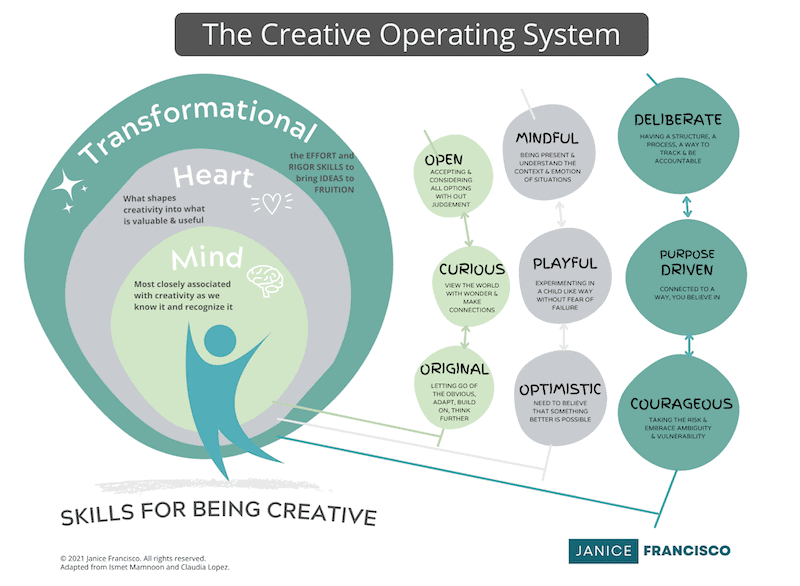What Does Innovative Thinking Mean?
If I were to answer the question, what does innovative thinker mean with this response – Leonardo da Vinci – I think you’d have a good sense of what it means, right?
Rodin’s famous sculpture, The Thinker, seen below at the AGO, portrays a solitary man thinking deeply. The world needs innovative thinkers who can solve problems creatively and collaboratively.
If you’re wondering what does innovative thinker mean or what does innovative thinking mean to organizations, you might be surprised to learn that the United Nations links creativity and innovation in problem-solving as critical to human development.

What does Innovative Thinker mean?
If I were to answer the question, what does innovative thinker mean with this response – Leonardo da Vinci – I think you’d have a good sense of what it means, right?
Da Vinci had a wide range of passions, pursuits and expertise; a diverse group of adoring friends, an insatiable curiosity, and the ability to take disparate ideas and see connections others didn’t.
He was emotionally intelligent and had superb observational skills. He relied on more than logic to understand a situation. He looked beyond what was immediately apparent and searched for meaning in expressions and emotions. He sought to understand the day’s technology and made unusual connections to find opportunities for the future.
He was authentic to himself, embraced diversity and possessed what in the day was called sfumato – he wasn’t afraid of gray areas. He didn’t attempt to operate from black-and-white thinking. Instead, he wanted to understand the whole and the components. He understood things as systems. By looking holistically and broadly, he could think in new ways, open to other possibilities, and create extraordinarily, imagining and detailing things in his notebooks, some of which have only recently seen the light of day. We are fortunate to have such a dedicated practice to keep notebooks, write his ideas, and develop them in detail.
I fondly recall a trip to Washington, D.C., where I visited a museum exhibiting da Vinci’s work. I found myself completely mesmerized by what this man conceived and invented in detail. His notebooks and drawings drew me in and captured my imagination. I looked in awe at his detailed sketches of airplanes, parachutes and other flying machines, a robot, a catapult, armoured vehicles, machine guns, kites and the diving suit. I got utterly lost in that exhibit; time stood still that afternoon as I drank it all in.
In a nutshell, da Vinci was highly creative, and because of that, he could be an innovative thinker. How to develop innovative ideas »
Suppose you think of people like da Vinci, who you could describe as creative. In that case, you’d think of someone curious, imaginative, willing to try new things, and surprising in their ability to look at things in new ways. They are playful, courageous, and driven by a sense of purpose. They get deeply immersed in their projects – some of which might seem absurd to others – and lose track of time, only to emerge days later, excited at having figured out something challenging or learning something new.
What does innovative thinking mean to organizations?
The Conference Board of Canada found that innovation is critical to an organization’s ability to sustain success.
Following Leonardo’s example, innovative thinkers don’t just have ideas; they know how to fully develop and stick with them through the long haul so they get accepted, adopted and implemented.
In organizations, innovative thinking means drawing on creativity, problem-solving and engaging in continuous improvement. It also means being entrepreneurial – seeing opportunities, managing the challenges of doing something new, and knowing how to assess and manage the risks associated with going in new directions. And it means understanding that it takes a village to develop and implement a good idea – which means that developing interpersonal skills, building relationships, enhancing communication and strengthening your implementation skills are critical to your success.
When innovative thinking is the modus operandi of individuals in an organization, it positively impacts the organization’s ability to be agile and resilient in the face of change. It boosts the organization’s immune system. It makes it easier to overcome adversity, like competition for resources, staying relevant in the market or afloat when you find the world around you is volatile, uncertain, complex or ambiguous.
How to become an innovative thinker
As we saw in the example of da Vinci’s behaviour, being creative is the core of being an innovative thinker. And an outcome of being creative is adaptability, agility, resilience, and well-being.
The good news about innovative thinking is that it’s teachable and improves with practice.
Below we outline these skills and offer some ways to develop them.
Build your own Creative Operating System™
Building on research conducted at the International Centre for Studies in Creativity, our colleague Ismet Mamnoon conceived the concept of the Creative Operating System™ to show how being creative is a function of balancing thinking skills (mindset) and emotional skills (heart set) with transformational skills that turn ideas into outcomes that create and sustain change.
Without these skills, we couldn’t tap the power of a deliberately creative process like creative problem-solving to enable innovative thinking. To master these skills, we need to develop observational and questioning skills, reframing and critical thinking skills, the ability to look at things from multiple perspectives, idea generation skills, and listening and acceptance skills.

1Mindset Skills
The core mindset skills in the Creative Operating System™ are, being open, being original, and being curious. They enable our ability to suspend judgment, actively seek novelty and genuinely explore something new.
2Heartset Skills
The emotional skill set – or heart set skills, influences how we engage with the world around us. They involve the skills of being mindful, being playful and being optimistic, allowing us to augment the mindset skills with the power of awareness, humour, and hopefulness so that we can develop the inner resilience needed to foster a sustainable effort for change.
Innovative thinking needs adaptability, agility, and stamina – we need to weather the creative process’s ups and downs, make sense of how we feel about our experience, and find the good in things that knock us off-kilter.
To develop these skills, we need to learn to be present in the moment, aware of our feelings and experiences, expand our imagination and sense of humour, learn to find joy in even the most adverse situations, and recognize and celebrate all wins. We must also learn how to build on ideas, hold the vision of a compelling outcome and believe in possibilities.
3Transformational Skills
And finally, transformational skills allow us to bring about the changes necessary to produce tangible results. They include the skills of being deliberate, being driven, and being courageous.
These skills allow us to stay focused on meaningful purpose, motivate us to manoeuvre around obstacles and rise when we run into setbacks.
They help us steady the ship when things go awry and give us the means to keep moving toward our goals.
Taking the first step, or even the next step when we do something new and creative, requires a tolerance for uncertainty and risk and the ability to embrace vulnerability and ambiguity.
In Summary
The abovementioned skills are those that fuel growth – in individuals and organizations.
Developing these skills involves learning to use a deliberately creative problem-solving process, being accountable, nurturing strong intrinsic motivation, becoming comfortable with vulnerability, ambiguity and uncertainty and that setbacks aren’t a failure because they’re chock full of valuable learning.
Want to Learn More?
Check out our Innovative Skills Training and learn about our preferred creative problem-solving process. Or schedule a discovery call to explore a customized learning solution for your team.
References
Davis, G.A. (1986). Creativity is forever. 4th ed. Dubuque, Iowa: Kendall/Hunt Publishing.
Mamnoon, I. (2019). The Creative Operating System. Buffalo, NY : creativitycards.net.
NowUknow (Dec 6, 2014). Top 7 Leonardo da Vinci inventions retrieved 2020-04-11 from this link.
Puccio, G.J., Mance, M., Murdock, M. (2011). Creative Leadership: Skills that drive change. Thousand Oaks, CA: Sage Publications.
Torrence, E.P. and Safter, H. (1999). Making the creative leap beyond. Buffalo, NY: Creative Education Press
Worrall, S. (November 4, 2017). What made Leonardo da Vinci a Genius? National Geographic Retrieved 2020-04-11


